AMPHIPOLIS MACEDONIA 158 BC Authentic NGC Certified AU Silver Ancient Greek Coin
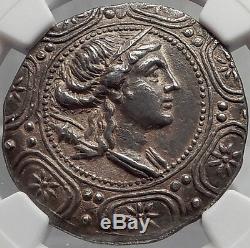

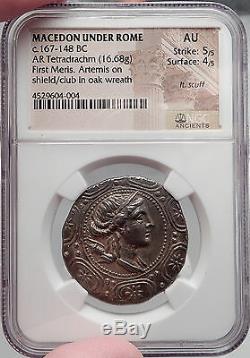
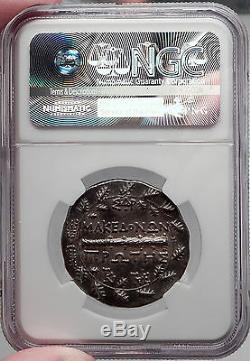
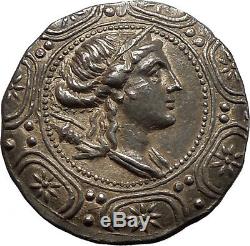
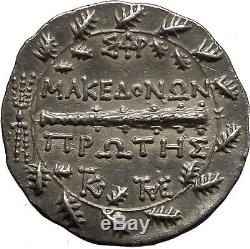


Macedonia Under the Romans Greek city of Amphipolis in Macedonia Silver Tetradrachm 32mm (16.68 grams) Struck 158-149 B. Reference: Sear 1386; SNG Cop. Certification: NGC Ancients AU Strike: 5/5 Surface: 4/5 4529604-004 Macedonian shield, at center of which but of Artemis Tauropolos right; bow and quiver at her shoulder.
MAKEON / above and below club right; in field above, monogram; all within oak-wreath, to left of which, thunderbolt. From the reopening of the silver mines to the revolt of Andriscus. Founded by Athenians in 436 B. To protect their mining interests in the north, Amphipolis surrendered to the Spartan general Brasidas in 424.
The city preserved its independence until 357 when it was captured by Philip II, King of Macedon. Artemis Tauropolos in ancient Greece, was an epithet for the goddess Artemis, variously interpreted as worshipped at Tauris, or pulled by a yoke of bulls, or hunting bull goddess.
A statue of Artemis "Tauropolos" in her temple at Brauron in Attica was supposed to have been brought from the Taurians by Iphigenia. Tauropolia was also a festival of Artemis in Athens. There was a Tauropolion , a temple in a temenos sacred to Artemis Tauropolos, in the north Aegean island of Doliche (now Ikaria). Artemis was one of the most widely venerated of the Ancient Greek deities. Some scholars believe that the name, and indeed the goddess herself, was originally pre-Greek. Homer refers to her as Artemis Agrotera, Potnia Theron < Artemis of the wildland, Mistress of Animals. In the classical period of Greek mythology, Artemis Greek: (nominative) , (genitive) was often described as the daughter of Zeus and Leto, and the twin sister of Apollo. She was the Hellenic goddess of the hunt, wild animals, wilderness, childbirth, virginity and young girls, bringing and relieving disease in women; she often was depicted as a huntress carrying a bow and arrows. The deer and the cypress were sacred to her.In later Hellenistic times, she even assumed the ancient role of Eileithyia in aiding childbirth. Artemis later became identified with Selene, a Titaness who was a Greek moon goddess, sometimes depicted with a crescent moon above her head.
She was also identified with the Roman goddess Diana, with the Etruscan goddess Artume, and with the Greek or Carian goddess Hecate. Macedonia or Macedon was an ancient kingdom on the northern periphery of Classical Greece and later the dominant state of Hellenistic Greece. It was ruled during most of its existence initially by the legendary founding dynasty of the Argeads, the intermittent Antipatrids and finally the Antigonids. Home to the Macedonians, the earliest kingdom was centered on the northeastern part of the Greek peninsula, bordered by Epirus to the west, Paeonia to the north, the region of Thrace to the east and Thessaly to the south. The rise of Macedon, from a small kingdom at the fringe of typical Greek city states affairs, to one which came to control the fate of the entire Hellenic world, occurred under the reign of Philip II. With the innovative Macedonian army, he defeated the old powers of Athens and Thebes in the decisive Battle of Chaeronea in 338 BC and subdued them, while keeping Sparta in check. His son Alexander the Great pursued his father's effort to command the whole of Greece through the federation of Greek states, a feat he finally accomplished after destroying a revolting Thebes.Young Alexander was then ready to lead this force, as he aspired, in a large campaign against the Achaemenid Empire, in retaliation for the invasion of Greece in the 5th century BC. In the ensuing wars of Alexander the Great, he was ultimately successful in conquering a territory that came to stretch as far as the Indus River. For a brief period his Macedonian Empire was the most powerful in the world, the definitive Hellenistic state, inaugurating the transition to this new period of Ancient Greek civilization. Greek arts and literature flourished in the new conquered lands and advancements in philosophy and science were spread to the ancient world. Of most importance were the contributions of Aristotle, a teacher to Alexander, whose teachings carried on many centuries past his death.
After the death of Alexander the Great wars of the Diadochi and the partitioning of his short-lived empire, Macedonia proper carried on as a Greek cultural and political center in the Mediterranean region along with Ptolemaic Egypt, the Seleucid Empire, and the Attalid kingdom. Important cities like Pella, Pydna, and Amphipolis were involved in power struggles for control of the territory, and new cities were founded, like Thessalonica by the usurper Cassander, which is now the second largest city of modern day Greece. Macedonia's decline of influence began with the rise of Rome until its ultimate subjection during the second Macedonian Wars.
The Roman province of Macedonia (Latin: Provincia Macedoniae , Greek:) was officially established in 146 BC, after the Roman general Quintus Caecilius Metellus defeated Andriscus of Macedon, the last self-styled King of the ancient kingdom of Macedonia in 148 BC, and after the four client republics (the "tetrarchy") established by Rome in the region were dissolved. The province incorporated ancient Macedonia, with the addition of Epirus, Thessaly, and parts of Illyria, Paeonia and Thrace.
This created a much larger administrative area, to which the name of'Macedonia' was still applied. The Dardanians, to the north of the Paeonians, were not included, because they had supported the Romans in their conquest of Macedonia. Amphipolis was an ancientnt Greek city in the region once inhabited by the Edoni people in the present-day periphery of Central Macedonia. It was built on a raised plateau overlooking the east bank of the river Strymon where it emerged from Lake Cercinitis, about 3 m. Founded in 437 BC, the city was finally abandoned in the 8th century AD. The present municipality Amfipoli, named after the ancient city, occupies the site. Currently, it is a municipality in the Serres Prefecture, Central Macedonia with a population of 3,623 (2001 census). Archaeology has uncovered remains at the site dating to approximately 3000 BC. Due to the strategic location of the site it was fortified from very early. Xerxes I of Persia passed during his invasion of Greece of 480 BC and buried alive nine young men and nine maidens as a sacrifice to the river god. Near the later site of Amphipolis Alexander I of Macedon defeated the remains of Xerxes' army in 479 BC.Throughout the 5th century BC, Athens sought to consolidate its control over Thrace, which was strategically important because of its primary materials (the gold and silver of the Pangaion hills and the dense forests essential for naval construction), and the sea routes vital for Athens' supply of grain from Scythia. After a first unsuccessful attempt at colonisation in 497 BC by the Miletian Tyrant Histiaeus, the Athenians founded a first colony at Ennea-Hodoi ('Nine Ways') in 465, but these first ten thousand colonists were massacred by the Thracians. A second attempt took place in 437 BC on the same site under the guidance of Hagnon, son of Nicias. The new settlement took the name of Amphipolis (literally, "around the city"), a name which is the subject of much debates about lexicography.
Thucydides claims the name comes from the fact that the Strymon flows "around the city" on two sides; however a note in the Suda (also given in the lexicon of Photius) offers a different explanation apparently given by Marsyas, son of Periander: that a large proportion of the population lived "around the city". However, a more probable explanation is the one given by Julius Pollux: that the name indicates the vicinity of an isthmus. Furthermore, the Etymologicum Genuinum gives the following definition: a city of the Athenians or of Thrace, which was once called Nine Routes, (so named) because it is encircled and surrounded by the Strymon river.
This description corresponds to the actual site of the city (see adjacent map), and to the description of Thucydides. Amphipolis subsequently became the main power base of the Athenians in Thrace and, consequently, a target of choice for their Spartans adversaries.
The Athenian population remained very much in the minority within the city. An Athenian rescue expedition led by strategist (and later historian) Thucydides had to settle for securing Eion and could not retake Amphipolis, a failure for which Thucydides was sentenced to exile. A new Athenian force under the command of Cleon failed once more in 422 BC during a battle at which both Cleon and Brasidas lost their lives.
Brasidas survived long enough to hear of the defeat of the Athenians and was buried at Amphipolis with impressive pomp. From then on he was regarded as the founder of the city and honoured with yearly games and sacrifices. The city itself kept its independence until the reign of the king Philip II despite several other Athenian attacks, notably because of the government of Callistratus of Aphidnae. In 357 BC, Philip removed the block which Amphipolis presented on the road to Macedonian control over Thrace by conquering the town, which Athens had tried in vain to recover during the previous years.After the conquest by Philip II, the city was not immediately incorporated into the kingdom, and for some time preserved its institutions and a certain degree of autonomy. The border of Macedonia was not moved further east; however, Philip sent a number of Macedonians governors to Amphipolis, and in many respects the city was effectively'Macedonianized'. Nomenclature, the calendar and the currency (the gold stater, installed by Philip to capitalise on the gold reserves of the Pangaion hills, replaced the Amphipolitan drachma) were all replaced by Macedonian equivalents. In the reign of Alexander, Amphipolis was an important naval base, and the birthplace of three of the most famous Macedonian Admirals: Nearchus, Androsthenes.
And Laomedon whose burial place is most likely marked by the famous lion of Amphipolis. Amphipolis became one of the main stops on the Macedonian royal road (as testified by a border stone found between Philippos and Amphipolis giving the distance to the latter), and later on the'Via Egnatia', the principal Roman Road which crossed the southern Balkans. Apart from the ramparts of the low town (see photograph), the gymnasium and a set well-preserved frescoes from a wealthy villa are the only artifacts from this period that remain visible. Though little is known of the layout of the town, modern knowledge of its institutions is in considerably better shape thanks to a rich epigraphic documentation, including a military ordinance of Philip V and an ephebarchic law from the gymnasium.
After the final victory of Rome over Macedonia in a battle in 168 BC, Amphipolis became the capital one of the four mini-republics, or'merides', which were created by the Romans out of the kingdom of the Antigonids which succeeded Alexander's Empire in Macedon. These'merides' were gradually incorporated into the Roman client state, and later province, of Thracia. During the period of Late Antiquity, Amphipolis benefited from the increasing economic prosperity of Macedonia, as is evidenced by the large number of Christian Churches that were built. Significantly however, these churches were built within a restricted area of the town, sheltered by the walls of the acropolis.
This has been taken as evidence that the large fortified perimeter of the ancient town was no longer defendable, and that the population of the city had considerably diminished. Nevertheless, the number, size and quality of the churches constructed between the fifth and sixth centuries are impressive.Four basilicas adorned with rich mosaic floors and elaborate architectural sculptures (such as the ram-headed column capitals - see picture) have been excavated, as well as a church with a hexagonal central plan which evokes that of the basilica of St. It is difficult to find reasons for such municipal extravagance in such a small town. Amphipolis was also a diocese under the suffragan of Thessaloniki - the Bishop of Amphipolis is first mentioned in 533 AD.
From the reduction of the urban area to the disappearance of the city. The Slavic invasions of the late 6th century gradually encroached on the back-country Amphipolitan lifestyle and led to the decline of the town, during which period its inhabitants retreated to the area around the acropolis.The ramparts were maintained to a certain extent, thanks to materials plundered from the monuments of the lower city, and the large unused cisterns of the upper city were occupied by small houses and the workshops of artisans. Around the middle of the 7th century AD, a further reduction of the inhabited area of the city was followed by an increase in the fortification of the town, with the construction of a new rampart with pentagonal towers cutting through the middle of the remaining monuments. The acropolis, the Roman baths, and especially the Episcopal basilica were crossed by this wall. The city was probably abandoned in the eighth century, as the last bishop was attested in 787. Its inhabitants probably moved to the neighbouring site of ancient Eion, port of Amphipolis, which had been rebuilt and refortified in the Byzantine period under the name "Chrysopolis".
This small port continued to enjoy some prosperity, before being abandoned during the Ottoman period. The last recorded sign of activity in the region of Amphipolis was the construction of a fortified tower to the north in 1367 by Grand Primicier Jean and the Stratopedarque Alexis to protect the land that they had given to the monastery of Pantokrator on Mount Athos. The site was rediscovered and described by many travellers and archaeologists during the 19th century, including E.
Feyel, of the École française d'Athènes, led an epigraphical mission to the site and uncovered the remains of a funeral lion (a reconstruction was given in the, a publication of the EfA which is available on line). However, excavations did not truly begin until after the Second World War. The Greek Archaeological Society under D. Lazaridis excavated in 1972 and 1985, uncovering a necropolis, the rampart of the old town (see photograph), the basilicas, and the acropolis.Demetrius of Amphipolis, student of Plato's. Zoilus (400 BC-320 BC), grammarian, cynic philosopher.
Pamphilus (painter), head of Sicyonian school and teacher of Apelles. Of Amphipolis 320 BC Stadion Olympics. 225 BC, stoic philosopher , follower of Persaeus. Xena, the Warrior Princess of Amphipolis.The item "AMPHIPOLIS MACEDONIA 158 BC Authentic NGC Certified AU Silver Ancient Greek Coin" is in sale since Saturday, November 8, 2014. This item is in the category "Coins & Paper Money\Coins\ Ancient\Greek (450 BC-100 AD)". The seller is "victoram" and is located in Forest Hills, New York. This item can be shipped worldwide.
- Culture: Greek
- Material: Silver
- Certification Number: 4529604-004
- Certification: NGC
- Grade: AU 5/5 4/5
- Composition: Silver
- Denomination: Tetradrachm


